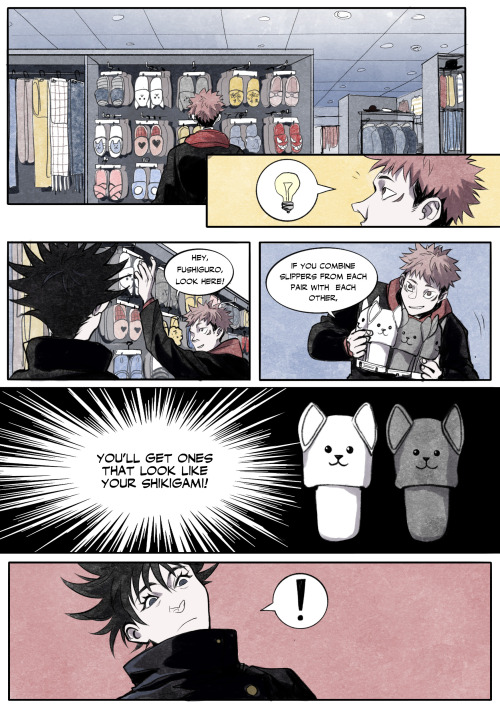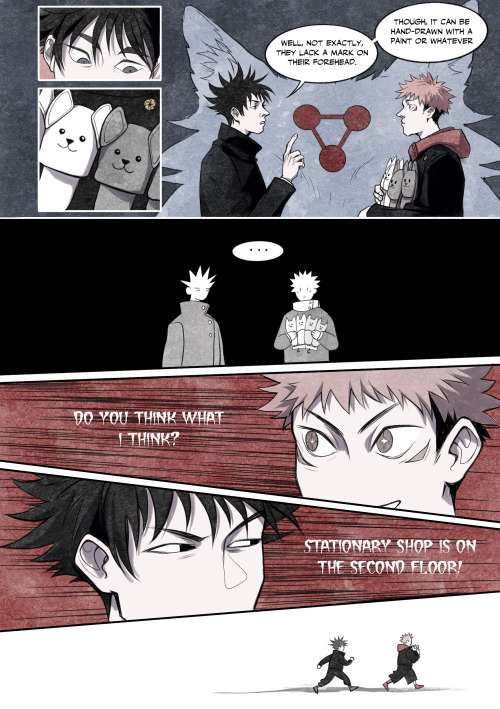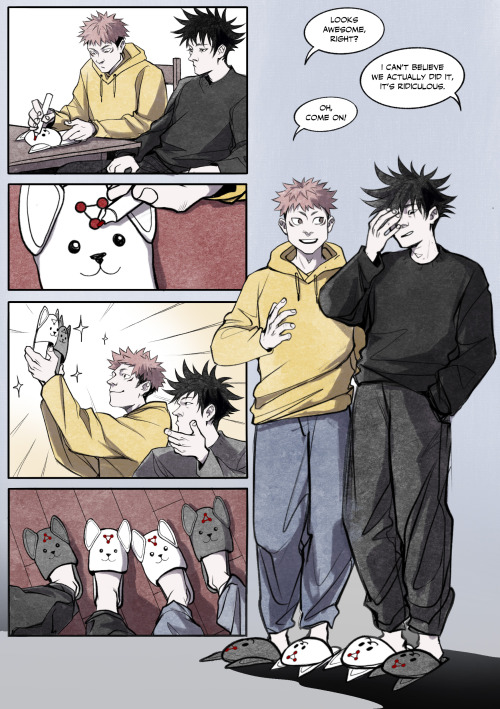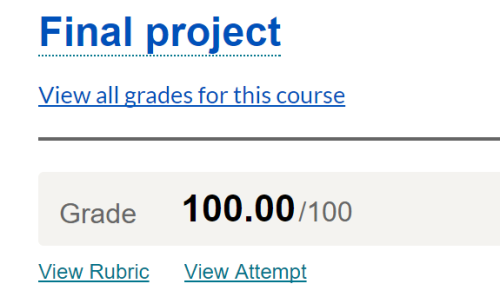I Couldn’t Stop Thinking About Shikigami Slippers From Jujutsu Kaisen Merch



I couldn’t stop thinking about shikigami slippers from jujutsu kaisen merch
More Posts from Whimsical-idiot and Others

this is the perfect grade of good luck
reblog in 5 seconds and all of your grades will inch ever closer to perfect

mya day

If you can’t reblog this, unfollow me now.
Body Language: Eyes
So I stumbled across this really useful thing which I use for writing and wanted to share it with you all.
(source: changingminds.org)
The eyes are often called, with some justification, ‘the windows of the soul’ as they can send many different non-verbal signals. For reading body language this is quite useful as looking at people’s eyes are a normal part of communication (whilst gazing at other parts of the body can be seen as rather rude). When a person wears dark glasses, especially indoors, this prevents others from reading their eye signals. It is consequently rather disconcerting, which is why ‘gangsters’ and those seeking to appear powerful sometimes wear them.
Looking Up
When a person looks upwards they are often thinking. In particular they are probably making pictures in their head and thus may well be an indicator of a visual thinker.
When they are delivering a speech or presentation, looking up may be their recalling their prepared words.
Looking upwards and to the left can indicate recalling a memory. Looking upwards and the right can indicate imaginative construction of a picture (which can hence betray a liar). Be careful with this: sometimes the directions are reversed — if in doubt, test the person by asking them to recall known facts or imagine something.
Looking up may also be a signal of boredom as the person examines the surroundings in search of something more interesting.
Head lowered and eyes looking back up at the other person is a coy and suggestive action as it combines the head down of submission with eye contact of attraction. It can also be judgemental, especially when combined with a frown.
Looking Down
Looking at a person can be an act of power and domination. Looking down involves not looking at the other person, which hence may be a sign of submission (‘I am not a threat, really; please do not hurt me. You are so glorious I would be dazzled if I looked at you.’)
Looking down can thus be a signal of submission. It can also indicate that the person is feeling guilty.
A notable way that a lower person looks down at a higher person is by tilting their head back. Even taller people may do this.
Looking down and to the left can indicate that they are talking to themselves (look for slight movement of the lips). Looking down and to the right can indicate that they are attending to internal emotions.
In many cultures where eye contact is a rude or dominant signal, people will look down when talking with others in order to show respect.
Looking Sideways
Much of our field of vision is in the horizontal plane, so when a person looks sideways, they are either looking away from what is in front of them or looking towards something that has taken their interest.
A quick glance sideways can just be checking the source of a distraction to assess for threat or interest. It can also be done to show irritation (‘I didn’t appreciate that comment!’).
Looking to the left can indicate a person recalling a sound. Looking to the right can indicate that they are imagining the sound. As with visual and other movements, this can be reversed and may need checking against known truth and fabrication.
Lateral movement
Eyes moving from side-to-side can indicate shiftiness and lying, as if the person is looking for an escape route in case they are found out.
Lateral movement can also happen when the person is being conspiratorial, as if they are checking that nobody else is listening.
Eyes may also move back and forth sideways (and sometimes up and down) when the person is visualizing a big picture and is literally looking it over.
Gazing
Looking at something shows an interest in it, whether it is a painting, a table or a person. When you look at something, then others who look at your eyes will feel compelled to follow your gaze to see what you are looking at. This is a remarkable skill as we are able to follow a gaze very accurately.
When looking at a person normally, the gaze is usually at eye level or above (see eye contact, below). The gaze can also be a defocused looking at the general person.
Looking at a person’s mouth can indicate that you would like to kiss them. Looking at sexual regions indicates a desire to have sexual relations with them.
Looking up and down at a whole person is usually sizing them up, either as a potential threat or as a sexual partner (notice where the gaze lingers). This can be quite insulting and hence indicate a position of presumed dominance, as the person effectively says ‘I am more powerful than you, your feelings are unimportant to me and you will submit to my gaze’.
Looking at their forehead or not at them indicates disinterest. This may also be shown by defocused eyes where the person is ‘inside their head’ thinking about other things.
The power gaze is a short but intense gaze that is used to impose one’s will on another, showing power without aggression.
It is difficult to conceal a gaze as we are particularly adept at identifying exactly where other people are looking. This is one reason why we have larger eye whites than animals, as it aids complex communication.
People who are lying may look away more often as they feel guilty when looking at others. However, when they know this, they may over-compensate by looking at you for longer than usual. This also helps them watch your body language for signs of detection.
The acceptable duration of a gaze varies with culture and sometimes even a slight glance is unacceptable, such as between genders or by a lower status person.
Non-visual gaze patterns (NVGPs) involve rapid movements (saccades) and fixations while we are ‘inside our heads’, thinking. Rapid movements happen more when we are accessing long-term memory and fixations more when we are accessing working memory. This is useful to detect whether people are thinking about older events or recent events (or old events that are already brought to working memory).
Glancing
Glancing at something can betray a desire for that thing, for example glancing at the door can indicate a desire to leave.
Glancing at a person can indicate a desire to talk with them. It can also indicate a concern for that person’s feeling when something is said that might upset them.
Glancing may indicate a desire to gaze at something or someone where it is forbidden to look for a prolonged period.
Glancing sideways at a person with raised eyebrows can be a sign of attraction. Without the raised eyebrow it is more likely to be disapproval.
Eye Contact
Eye contact between two people is a powerful act of communication and may show interest, affection or dominance.
Doe Eyes
A softening of the eyes, with relaxing of muscles around the eye and a slight defocusing as the person tries to take in the whole person is sometimes called doe eyes, as it often indicates sexual desire, particularly if the gaze is prolonged and the pupils are dilated (see below). The eyes may also appear shiny.
Making Eye Contact
Looking at a person acknowledges them and shows that you are interested in them, particularly if you look in their eyes.
Looking at a person’s eyes also lets you know where they are looking. We are amazingly good at detecting what they are looking at and can detect even a brief glance at parts of our body, for example.
If a person says something when you are looking away and then you make eye contact, then this indicates they have grabbed your attention.
Breaking eye contact
Prolonged eye contact can be threatening, so in conversation we frequently look away and back again.
Breaking eye contact can indicate that something that has just been said that makes the person not want to sustain eye contact, for example that they are insulted, they have been found out, they feel threatened, etc. This can also happen when the person thinks something that causes the same internal discomfort. Of course, a break in eye contact can also be caused by something as simple as dried out contacts or any new stimulus in one’s immediate area, so it’s important to watch for other signals.
Looking at a person, breaking eye contact and then looking immediately back at them is a classic flirting action, particularly with the head held coyly low in suggested submission.
Long eye contact
Eye contact longer than normal can have several different meanings.
Eye contact often increases significantly when we are listening, and especially when we are paying close attention to what the other person is saying. Less eye contact is used when talking, particularly by people who are visual thinkers as they stare into the distance or upwards as they ‘see’ what they are talking about.
We also look more at people we like and like people who look at us more. When done with doe eyes and smiles, it is a sign of attraction. Lovers will stare into each others eyes for a long period. Attraction is also indicated by looking back and forth between the two eyes, as if we are desperately trying to determine if they are interested in us too.
An attraction signal that is more commonly used by women is to hold the other person’s gaze for about three seconds, Then look down for a second or two and then look back up again (to see if they have taken the bait). If the other person is still looking at them, they are rewarded with a coy smile or a slight widening of the eyes (‘Yes, this message is for you!’).
When done without blinking, contracted pupils and an immobile face, this can indicate domination, aggression and use of power. In such circumstances a staring competition can ensue, with the first person to look away admitting defeat.
Prolonged eye contact can be disconcerting. A trick to reduce stress from this is to look at the bridge of their nose. They will think you are still looking in their eyes.
Sometimes liars, knowing that low eye contact is a sign of lying, will over-compensate and look at you for a longer than usual period. Often this is done without blinking as they force themselves into this act. They may smile with the mouth, but not with the eyes as this is more difficult.
Limited eye contact
When a person makes very little eye contact, they may be feeling insecure. They may also be lying and not want to be detected.
In persuasion
Eye contact is very important for persuasion. If you look at the other person and they do not look back at you, then their attention is likely elsewhere. Even if they hear you, the lack of eye contact reduces the personal connection.
If you want to persuade or change minds, then the first step is to gain eye contact and then sustain it with regular reconnection.
Staring
Staring is generally done with eyes wider than usual, prolonged attention to something and with reduced blinking. It generally indicates particular interest in something or someone.
Staring at a person can indicate shock and disbelief, particularly after hearing unexpected news.
When the eyes are defocused, the person’s attention may be inside their head and what they are staring at may be of no significance. (Without care, this can become quite embarrassing for them).
Prolonged eye contact can be aggressive, affectionate or deceptive and is discussed further above. Staring at another’s eyes is usually more associated with aggressive action.
A short stare, with eyes wide open and then back to normal indicates surprise. The correction back to normal implies that the person would like to stare more, but knows it is impolite (this may be accompanied with some apologetic text).
When a person stares at another, then the second person may be embarrassed and look away. If they decide to stare back, then the people ‘lock eyes’ and this may become a competition with the loser being the person who looks away first.
The length of an acceptable stare varies across cultures, as does who is allowed to stare, and at what. Babies and young children stare more, until they have learned the cultural rules.
Following
The eyes will naturally follow movement of any kind. If the person is looking at something of interest then they will naturally keep looking at this. They also follow neutral or feared things in case the movement turns into a threat.
This is used when sales people move something like a pen or finger up and down, guiding where the customer looks, including to eye contact and to parts of the product being sold.
Squinting
Narrowing of a person’s eyes can indicate evaluation, perhaps considering that something told to them is not true (or at least not fully so).
Squinting can also indicate uncertainty (‘I cannot quite see what is meant here.’)
Narrowing eyes has a similar effect to constricted pupils in creating a greater depth of field so you can see more detail. This is used by animals when determining distance to their prey and can have a similar aggressive purpose.
Squinting can be used by liars who do not want the other person to detect their deception.
When a person thinks about something and does not want to look at the internal image, they may involuntarily squint.
Squinting can also happen when lights or the sun are bright.
Lowering of eyelids is not really a squint but can have a similar meaning. It can also indicate tiredness.
Lowering eyelids whilst still looking at the other person can be a part of a romantic and suggestive cluster, and may be accompanied with tossing back the head and slightly puckering the lips in a kiss.
Blinking
Blinking is a neat natural process whereby the eyelids wipe the eyes clean, much as a windscreen wiper on a car.
Blink rate tends to increase when people are thinking more or are feeling stressed. This can be an indication of lying as the liar has to keep thinking about what they are saying. Realizing this, they may also force their eyes open and appear to stare.
Blinking can also indicate rapport, and people who are connected may blink at the same rate. Someone who is listening carefully to you is more likely to blink when you pause (keeping eyes open to watch everything you say).
Beyond natural random blinking, a single blink can signal surprise that the person does not quite believe what they see (‘I’ll wipe my eyes clean to better see’).
Rapid blinking blocks vision and can be an arrogant signal, saying ‘I am so important, I do not need to see you’.
Rapid blinking also flutters the eyelashes and can be a coy romantic invitation.
Reduced blinking increases the power of a stare, whether it is romantic or dominant in purpose.
Winking
Closing one eye in a wink is a deliberate gesture that often suggests conspiratorial (‘You and I both understand, though others do not’).
Winking can also be a slightly suggestive greeting and is reminiscent of a small wave of the hand (‘Hello there, gorgeous!’).
Closing
Closing the eyes shuts out the world. This can mean ‘I do not want to see what is in front of me, it is so terrible’.
Sometimes when people are talking they close their eyes. This is an equivalent to turning away so eye contact can be avoided and any implied request for the other person to speak is effectively ignored.
Visual thinkers may also close their eyes, sometimes when talking, so they can better see the internal images without external distraction.
Damp
The tear ducts provide moisture to the eyes, both for washing them and for tears.
Damp eyes can be suppressed weeping, indicating anxiety, fear or sadness. It can also indicate that the person has been crying recently.
Dampness can also occur when the person is tired (this may be accompanied by redness of the eyes.
Tears
Actual tears that roll down the cheeks are often a symptom of extreme fear or sadness, although paradoxically you can also weep tears of joy.
Weeping can be silent, with little expression other than the tears (indicating a certain amount of control). It also typically involves screwing up of the face and, when emotions are extreme, can be accompanied by uncontrollable, convulsive sobs.
Men in many culture are not expected to cry and learn to suppress this response, not even being able to cry when alone. Even if their eyes feel damp they may turn away.
Tears and sadness may be transformed into anger, which may be direct at whoever is available.
Pupil Size
A subtle signal that is sometimes detected only subconsciously and is seldom realized by the sender is where the pupil gets larger (dilates) or contracts.
Sexual desire is a common cause of pupil dilation, and is sometimes called ‘doe eyes’ or ‘bedroom eyes’ (magazine pictures sometimes have deliberately doctored eyes to make a model look more attractive). When another person’s eyes dilate we may be attracted further to them and our eyes dilate in return. Likewise, when their pupils are small, ours may well contract also.
A fundamental cause of eye dilation is cognitive effort. When we are thinking more, our eyes dilate. This helps explain ‘doe eyes’ as when we like others people, looking at them leads to significant thinking about how we may gain and sustain their attention.
Pupils dilate also when it is darker to let in more light. Perhaps this is why clubs, bars, restaurants and other romantic venues are so dingy.
People with dark irises (the colored circle around the pupil) can look attractive because it is difficult to distinguish the iris from the pupil, with the effect is that their dark pupils look larger than they are. People with light irises make the pupils easier to see, so when their pupils actually do dilate then the signal is clearer to detect, making them more attractive ‘at the right time’.
The reverse of this is that pupils contract when we do not like the other person, perhaps in an echo of squint-like narrowing of the eyes. People with small pupils can hence appear threatening or just unpleasant.
Rubbing
When a person is feeling uncomfortable, the eyes may water a little. To cover this and try to restore an appropriate dryness, they person may rub their eye and maybe even feign tiredness or having something in the eye. This also gives the opportunity to turn the head away.
The rubbing may be with one finger, with a finger and thumb (for two eyes) or with both hands. The more the coverage, the more the person is trying to hide behind the hands.















So, after four days of fighting with the sewing machine, broken threaders, and so much fraying, I finally finished this shan! It will be my first shan in this style - because when it finally started to be fashionable, I stopped buying much hanfu… Also I really hate when the bottom hem is uneven on me, so it will have to be tailored-made instead of buying from the rack.
This post only talks about drafting the patterns and the measurement. The steps of making… I think @yi-gege‘s post here should be enough. I usually sew in the following sequence (not sure if it is the right way of doing it): the back seam, the sleeves, front and back, the collar, and at last the bottom and sleeve hems.
This post also includes some tips on the back seam, the arm pit, the bottom hem, bar-tack at the vents and what to do if you ran out of fabric. Also, while I did not put it in the slides, but do remember to iron before and after sewing every seam to get a sharp finish.
There will be another post specifically on how to collar a hanfu.
I hope this post is understandable LOL.
Masterlist for learning languages
Brick-by-brick language learning challenge
Best language learning tips & masterlists from other bloggers I’ve come across
my tips for a language study plan
topics for new vocabulary
how to find a language partner
my tips for how to practice writing in your target language
Recommendations for Learning Languages & Other Stuff
Learning a language = learning a culture
Vocab list templates: #1, #2, #3
Some easy Fantasy books to read in your target language
Language Learning Tips: #1, #2
6 tips for learning languages
App for organizing your language-learning (and anything else): Trello
Apps i use to learn languages
|
Requests / Asks:
-> you can find all my answered asks by searching for #ask, #ask response or #request
Indo-European Language Families
Improving your vocab
German infinitive & when to use it
English word order
How to find a language learning partner
Changing a game to your target language & "harmful" learning strategies
Can you get away with just using "das" the majority of the time in Germany?
Do you have any tips on how to improve your writing in your target language?
Do you have any resources/methods about how to reach an academic level in the language you’re learning (& how to improve your writing)?
Do you have any linguistic recourses on Ruhrpott-Deutsch?

I think part of the reason why social skills lessons are always so vague and surface level is because if neurotypicals actually tried to explain their unspoken social rules, they'd have to face how nonsensical and messed up a lot of them are
the men and boys are innocent too.
we cry "the innocent women and children" to appeal to the masses, to try and force their sympathy, but the men and boys are innocent too.
I have seen sons crying out for their mothers, their fathers, their siblings. I have seen them break down at the loss of their families. I have seen them cling to their dead and grieve.
I have seen fathers cradle their dead children, seen them kiss their faces and hold their little hands. I have seen them faint with grief when asked to identify the dead. I have seen them carry their sons and daughters. I have seen them fasting to provide what little they can for their families.
I have seen men and boys digging through the rubble with just their bare hands, I have seen them comforting strangers, playing with children, rocking them, hushing them, even if the face of such imminent danger. I have seen them cry, seen them grieve, seen them break down into each other's arms, seen them be selfless, beyond selfless, becoming something I don't have a word for.
I have seen the men who are doctors refuse to leave their patients, even when they have no medicine or supplies to give them, even when they're threatened with bombings. I have seen fathers who have lost all their children pick orphans up into their arms and proclaim them their child so they are not alone. I have seen men and boys digging pets out of the rubble.
the men are innocent too. the men and boys are being hurt and killed too. the men and boys are grieving too. the men and boys are scared too. the men and boys are fighting to save their people too. the men and boys deserve to be fought for too.
-
 fizzysodadrink liked this · 1 week ago
fizzysodadrink liked this · 1 week ago -
 wishful-author liked this · 2 weeks ago
wishful-author liked this · 2 weeks ago -
 lorddoodle liked this · 2 weeks ago
lorddoodle liked this · 2 weeks ago -
 burdigel liked this · 3 weeks ago
burdigel liked this · 3 weeks ago -
 sanatan2007 liked this · 1 month ago
sanatan2007 liked this · 1 month ago -
 legendarydaimon liked this · 1 month ago
legendarydaimon liked this · 1 month ago -
 lilliganreblogs reblogged this · 1 month ago
lilliganreblogs reblogged this · 1 month ago -
 rabbitsartcorner reblogged this · 1 month ago
rabbitsartcorner reblogged this · 1 month ago -
 rabbitsartcorner liked this · 1 month ago
rabbitsartcorner liked this · 1 month ago -
 lacasadelassombras liked this · 1 month ago
lacasadelassombras liked this · 1 month ago -
 mourningjaytakeflight liked this · 1 month ago
mourningjaytakeflight liked this · 1 month ago -
 blue-and-violet-flowers liked this · 1 month ago
blue-and-violet-flowers liked this · 1 month ago -
 artsy-guinea-piggy liked this · 2 months ago
artsy-guinea-piggy liked this · 2 months ago -
 thatinsanefanbitch liked this · 2 months ago
thatinsanefanbitch liked this · 2 months ago -
 sirenafterdark liked this · 2 months ago
sirenafterdark liked this · 2 months ago -
 nearsightedlizard liked this · 2 months ago
nearsightedlizard liked this · 2 months ago -
 reki-kyan-uwu liked this · 2 months ago
reki-kyan-uwu liked this · 2 months ago -
 eyeofthelost liked this · 2 months ago
eyeofthelost liked this · 2 months ago -
 breadseed150 liked this · 2 months ago
breadseed150 liked this · 2 months ago -
 yaetaemcray liked this · 2 months ago
yaetaemcray liked this · 2 months ago -
 asherrpookie liked this · 3 months ago
asherrpookie liked this · 3 months ago -
 baconboimcgee liked this · 3 months ago
baconboimcgee liked this · 3 months ago -
 beesarefiends liked this · 3 months ago
beesarefiends liked this · 3 months ago -
 eighter20 liked this · 3 months ago
eighter20 liked this · 3 months ago -
 socially-anxious-wizard reblogged this · 3 months ago
socially-anxious-wizard reblogged this · 3 months ago -
 originsofevil reblogged this · 3 months ago
originsofevil reblogged this · 3 months ago -
 originsofevil reblogged this · 3 months ago
originsofevil reblogged this · 3 months ago -
 originsofevil liked this · 3 months ago
originsofevil liked this · 3 months ago -
 floralpoetrydyke reblogged this · 3 months ago
floralpoetrydyke reblogged this · 3 months ago -
 mistress-0f-sin liked this · 3 months ago
mistress-0f-sin liked this · 3 months ago -
 sofiazsstuff liked this · 3 months ago
sofiazsstuff liked this · 3 months ago -
 mushpired liked this · 4 months ago
mushpired liked this · 4 months ago -
 grimates liked this · 4 months ago
grimates liked this · 4 months ago -
 mouriros liked this · 4 months ago
mouriros liked this · 4 months ago -
 dark-time35 liked this · 4 months ago
dark-time35 liked this · 4 months ago -
 probablynotreallyhere liked this · 4 months ago
probablynotreallyhere liked this · 4 months ago -
 ravenpureforever reblogged this · 4 months ago
ravenpureforever reblogged this · 4 months ago -
 yujilvr9000 reblogged this · 4 months ago
yujilvr9000 reblogged this · 4 months ago -
 joe-mamajoemama liked this · 4 months ago
joe-mamajoemama liked this · 4 months ago -
 petes9782 liked this · 4 months ago
petes9782 liked this · 4 months ago -
 oofbitchxx33-blog liked this · 4 months ago
oofbitchxx33-blog liked this · 4 months ago -
 byler-fuels-my-soul liked this · 4 months ago
byler-fuels-my-soul liked this · 4 months ago -
 vertigoambrosia reblogged this · 4 months ago
vertigoambrosia reblogged this · 4 months ago -
 fuckyeahnewhollywood liked this · 4 months ago
fuckyeahnewhollywood liked this · 4 months ago -
 bitch410 liked this · 5 months ago
bitch410 liked this · 5 months ago -
 harumichan12 liked this · 5 months ago
harumichan12 liked this · 5 months ago -
 warfangwhowrote reblogged this · 5 months ago
warfangwhowrote reblogged this · 5 months ago -
 kappalola liked this · 5 months ago
kappalola liked this · 5 months ago -
 mygh0stcrush reblogged this · 5 months ago
mygh0stcrush reblogged this · 5 months ago
